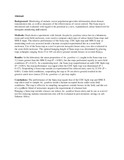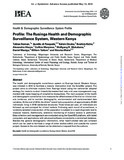Search
Now showing items 1-10 of 18
Understanding the long-lasting attraction of malaria mosquitoes to odor baits.
(University of Nairobi, 2015)
The use of odor baits for surveillance and control of malaria mosquitoes requires robust dispensing tools. In this study, the residual activity of a synthetic mosquito attractant blend dispensed from nylon or low density ...
Variation in malaria transmission dynamics in three different sites in Western kenya
(2012)
The main objective was to investigate malaria transmission dynamics in three different sites, two highland villages (Fort Ternan and Lunyerere) and a lowland peri-urban area (Nyalenda) of Kisumu city. Adult mosquitoes were ...
Development and optimization of the Suna trap as a tool for mosquito monitoring and control
(University of Nairobi, 2014)
Background: Monitoring of malaria vector populations provides information about disease transmission risk, as well
as measures of the effectiveness of vector control. The Suna trap is introduced and evaluated with regard ...
Development and field evaluation of a synthetic mosquito lure that is more attractive than humans
(2010)
Disease transmitting mosquitoes locate humans and other blood hosts by identifying their characteristic odor profiles. Using their olfactory organs, the mosquitoes detect compounds present in human breath, sweat and skins, ...
The SolarMal Project: innovative mosquito trapping technology for malaria control
(University of Nairobi, 2012)
Repellent Activities of Essential Oils of Some Plants Used Traditionally to Control the Brown Ear Tick, Rhipicephalus appendiculatus.
(University of Nairobi, 2014-02)
Essential oils of eight plants, selected after an ethnobotanical survey conducted in Bukusu community in Bungoma County, western Kenya (Tagetes minuta, Tithonia diversifolia, Juniperus procera, Solanecio mannii, Senna ...
2-Butanone as a carbon dioxide mimic in attractant blends for the Afrotropical malaria mosquitoes Anopheles gambiae and Anopheles funestus.
(University of Nairobi, 2017)
BACKGROUND:
Most odour baits designed to attract host-seeking mosquitoes contain carbon dioxide (CO2), which enhances trap catches, given its role as a mosquito flight activator. However, the use of CO2 is expensive and ...
The effect of mass mosquito trapping on malaria transmission and disease burden (SOLARMAL): a stepped-wedge cluster-randomised trial.
(Unuversity of Nairobi, 2016)
BACKGROUND:
Odour baits can attract host-seeking Anopheles mosquitoes indoors and outdoors. We assessed the effects of mass deployment of odour-baited traps on malaria transmission and disease burden.
METHODS:
We ...
Mass mosquito trapping for malaria control in western Kenya: study protocol for a stepped wedge cluster-randomised trial.
(University of Nairobi, 2016)
BACKGROUND:
Increasing levels of insecticide resistance as well as outdoor, residual transmission of malaria threaten the efficacy of existing vector control tools used against malaria mosquitoes. The development of ...
Profile: the Rusinga health and demographic surveillance system, western Kenya.
(University of Nairobi, 2016)
The health and demographic surveillance system on Rusinga Island, Western Kenya, was initiated in 2012 to facilitate a malaria intervention trial: the SolarMal project. The project aims to eliminate malaria from Rusinga ...






